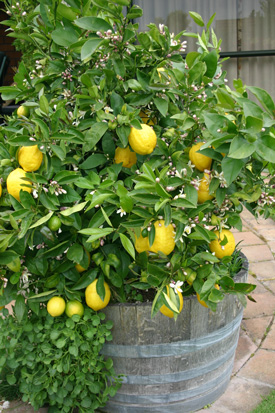The essential lemon tree
A gin and tonic isn’t quite the same without it. Even more important, the trusty lemon fulfills all manner of culinary requirements; from marinades to dressings, to homemade lemonade for summer and hot soothing drinks for winter. And only lemon rivals chocolate in the most heavenly of heavenly desserts.
Unlike oranges and mandarins, lemon and lime trees keep growing all year round, which means that they’ll fruit all year in a frost free climate. The downside of this is that lemons and limes are the most cold-sensitive of citrus and the least able to recover from an encounter with Jack Frost.
The colder the climate the greater the challenge, but there are ways and means to get around this. First, choose a cold-tolerant variety (‘Meyer’ is the most cold- hardy lemon. ‘Lemonade’ and ‘Yen Ben’ can cope with a light frost once established), then plant it in your warmest, most sheltered spot. A north or west facing brick or concrete wall provides an ideal microclimate but be aware that you may need to water more often as the soil close to walls tends to be dry. Another way to harness the sun’s warmth is to mulch beneath trees with pebbles.
Growing citrus in containers is the centuries-old solution for a cold winter climate. If you need to bring your tree indoors, a small greenhouse or brightly lit conservatory is best as the lower light levels inside most living rooms are less then ideal. Either way, have the tree indoors for as short a time as possible. Whether they are in pots or planted in the ground, citrus trees will respond well to floor paving, pebbles or gravel to trap and radiate the heat.
When temperatures are forecast to plummet, be ready with frost cloth. Young trees are the most vulnerable, and autumn growth that hasn’t had time to mature will get hit with an early frost. Frost cloth should be removed during the day.
The fundamentals of timely watering and feeding are all the more important for citrus trees in cool climates, because healthy trees are the most frost tolerant and a good canopy of foliage shelters the fruit during a frost. Feed and water generously over spring and summer but stop feeding in late summer until next spring; otherwise you risk soft new growth susceptible to frost damage. For the same reason, prune only in spring. If the tree does get burnt, avoid the temptation to prune off the damage until after the risk of frost.
Lemon Tree Basics
- Plant in a sunny, sheltered place with well drained soil.
- Feed generously during spring and summer. Apply controlled release citrus fertiliser and supplement with liquid plant food or frequent doses of worm tea from your worm farm.
- Water regularly and deeply, especially during the first three years after planting. Trees in containers need watering every two or three days during hot summer weather.
Tips:
Remove fruit in the first season to channel energy into strong growth.
Spray with copper at petal fall and again two weeks later to prevent diseases.
Meyer, the most popular lemon, is not only more cold tolerant than other lemons but is also very compact, ideal for growing in a pot. Because Meyer lemon trees grow well from cuttings, they are widely available and very affordable. A Meyer lemon is actually a hybrid between a lemon and a hardier citrus, thought to be a mandarin, hence its superior cold hardiness. The tree fruits heavily year after year and the ripe fruit will last several months on the tree.
3-Jun-2013



